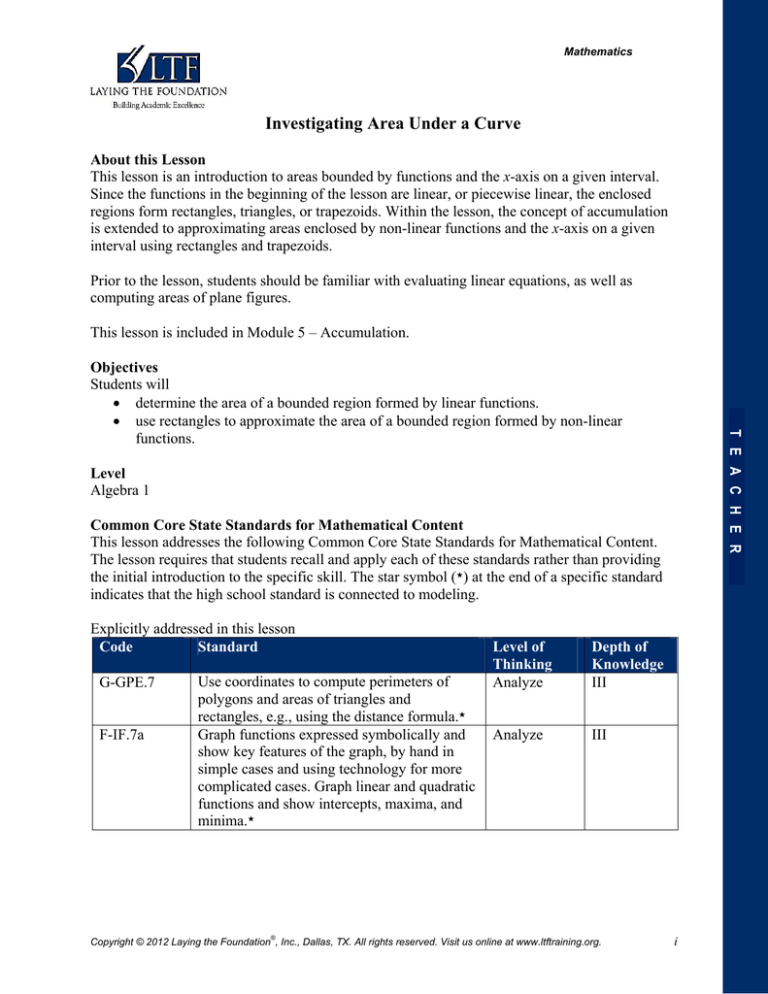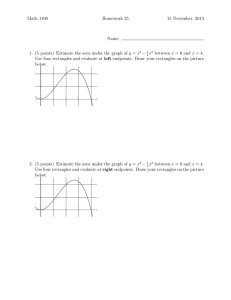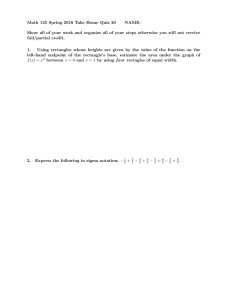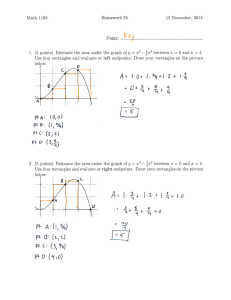
Mathematics
Investigating Area Under a Curve
About this Lesson
This lesson is an introduction to areas bounded by functions and the x-axis on a given interval.
Since the functions in the beginning of the lesson are linear, or piecewise linear, the enclosed
regions form rectangles, triangles, or trapezoids. Within the lesson, the concept of accumulation
is extended to approximating areas enclosed by non-linear functions and the x-axis on a given
interval using rectangles and trapezoids.
Prior to the lesson, students should be familiar with evaluating linear equations, as well as
computing areas of plane figures.
This lesson is included in Module 5 – Accumulation.
T E A C H E R
Objectives
Students will
determine the area of a bounded region formed by linear functions.
use rectangles to approximate the area of a bounded region formed by non-linear
functions.
Level
Algebra 1
Common Core State Standards for Mathematical Content
This lesson addresses the following Common Core State Standards for Mathematical Content.
The lesson requires that students recall and apply each of these standards rather than providing
the initial introduction to the specific skill. The star symbol (★) at the end of a specific standard
indicates that the high school standard is connected to modeling.
Explicitly addressed in this lesson
Code
Standard
G-GPE.7
F-IF.7a
Use coordinates to compute perimeters of
polygons and areas of triangles and
rectangles, e.g., using the distance formula.★
Graph functions expressed symbolically and
show key features of the graph, by hand in
simple cases and using technology for more
complicated cases. Graph linear and quadratic
functions and show intercepts, maxima, and
minima.★
®
Level of
Thinking
Analyze
Depth of
Knowledge
III
Analyze
III
Copyright © 2012 Laying the Foundation , Inc., Dallas, TX. All rights reserved. Visit us online at www.ltftraining.org.
i
Teacher Overview – Investigating Area Under a Curve
Code
Standard
F-IF.5
Relate the domain of a function to its graph
and, where applicable, to the quantitative
relationship it describes. For example, if the
function h(n) gives the number of personhours it takes to assemble n engines in a
factory, then the positive integers would be an
appropriate domain for the function.★
Level of
Thinking
Apply
Depth of
Knowledge
II
Common Core State Standards for Mathematical Practice
These standards describe a variety of instructional practices based on processes and proficiencies
that are critical for mathematics instruction. LTF incorporates these important processes and
proficiencies to help students develop knowledge and understanding and to assist them in
making important connections across grade levels. This lesson allows teachers to address the
following Common Core State Standards for Mathematical Practice.
Implicitly addressed in this lesson
Code
Standard
Make sense of problems and persevere in solving them.
Reason abstractly and quantitatively.
Construct viable arguments and critique the reasoning of others.
Model with mathematics.
Attend to precision.
®
Copyright © 2012 Laying the Foundation , Inc., Dallas, TX. All rights reserved. Visit us online at www.ltftraining.org.
T E A C H E R
1
2
3
4
6
ii
Teacher Overview – Investigating Area Under a Curve
LTF Content Progression Chart
In the spirit of LTF’s goal to connect mathematics across grade levels, the Content Progression
Chart demonstrates how specific skills build and develop from sixth grade through pre-calculus.
Each column, under a grade level or course heading, lists the concepts and skills that students in
that grade or course should master. Each row illustrates how a specific skill is developed as
students advance through their mathematics courses.
7th Grade
Skills/Objectives
Calculate total area
by summing areas
of connected
geometric figures
and/or approximate
area by counting
squares or by using
left-hand rectangles,
right-hand
rectangles, or
trapezoids in
graphical contexts.
(200_07.AC_E.01)
Compare
approximation
methods and/or
determine and
justify whether an
approximation is an
overestimate or an
underestimate.
(200_06.AC_E.02)
Compare
approximation
methods, determine
and justify whether
an approximation is
an overestimate or
an underestimate,
and/or interpret the
meaning of
accumulated area.
(200_07.AC_E.02)
Algebra 1
Skills/Objectives
Calculate total area
by summing areas
of connected
geometric figures
and/or approximate
area using left-hand
rectangles, righthand rectangles,
midpoint rectangles,
or trapezoids in
verbal, graphical,
numerical, and
analytical contexts
including rate
graphs.
(200_A1.AC_E.01)
Compare
approximation
methods, determine
and justify whether
an approximation is
an overestimate or
an underestimate,
and/or interpret the
meaning of
accumulated area.
(200_A1.AC_E.02)
Geometry
Algebra 2
Pre-Calculus
Skills/Objectives
Skills/Objectives
Skills/Objectives
Calculate total area Calculate total area Calculate total area
by summing areas of by summing areas of by summing areas of
connected geometric connected geometric connected geometric
figures and/or
figures and/or
figures and/or
approximate area
approximate area
approximate area
using left-hand
using left-hand
using left-hand
rectangles, rightrectangles, rightrectangles, righthand rectangles,
hand rectangles,
hand rectangles,
midpoint rectangles, midpoint rectangles, midpoint rectangles,
or trapezoids in
or trapezoids in
or trapezoids in
verbal, graphical,
verbal, graphical,
verbal, graphical,
numerical, and
numerical, and
numerical, and
analytical contexts analytical contexts analytical contexts
including rate
including rate
including rate
graphs.
graphs.
graphs.
(200_GE.AC_E.01) (200_A2.AC_E.01) (200_PC.AC_E.01)
Compare
Compare
Compare
approximation
approximation
approximation
methods, determine methods, determine methods, determine
and justify whether and justify whether and justify whether
an approximation is an approximation is an approximation is
an overestimate or an an overestimate or an an overestimate or an
underestimate,
underestimate,
underestimate,
and/or interpret the and/or interpret the and/or interpret the
meaning of
meaning of
meaning of
accumulated area. accumulated area. accumulated area.
(200_GE.AC_E.02) (200_A2.AC_E.02) (200_PC.AC_E.02)
Connection to AP*
AP Calculus Topic: Accumulation
*Advanced Placement and AP are registered trademarks of the College Entrance Examination Board.
The College Board was not involved in the production of this product.
Materials and Resources
Student Activity pages
Graphing calculators
Assessments
The following types of formative assessments are embedded in this lesson:
Students engage in independent practice.
Students apply knowledge to a new situation.
The following additional assessments are located on the LTF website:
Accumulation – Algebra 1 Free Response Questions
Accumulation – Algebra 1 Multiple Choice Questions
®
Copyright © 2012 Laying the Foundation , Inc., Dallas, TX. All rights reserved. Visit us online at www.ltftraining.org.
iii
T E A C H E R
6th Grade
Skills/Objectives
Calculate and/or
approximate area by
counting squares or
by using left-hand
rectangles, righthand rectangles, or
trapezoids in
graphical contexts.
(200_06.AC_E.01)
Teacher Overview – Investigating Area Under a Curve
Teaching Suggestions
In question 1, all of the functions are linear, so the students should calculate the exact area of the
bounded region. Demonstrate how to drop the vertical boundaries from the function to the x-axis
at the endpoints of the interval, and then discuss using only vertical lines to divide the figure into
triangles, rectangles, and/or trapezoids. Calculate the areas of the geometric figures then sum
(accumulate) the values to determine the total area of the region.
In questions 2 and 3, students are asked to approximate the area of the region bounded by a curve
and the x-axis on a given interval. Since the functions are curved, the exact area cannot be
determined using only algebraic techniques. Explain that the vertical lines drawn from known
points of the function to the x-axis will be used to create the sides of rectangles, These vertical
line segments are not the same length; therefore, the students must determine where to locate the
tops of the rectangles. One of two rules is generally applied in this lesson: (1) draw the top of the
rectangle from the top of the vertical segment on the left (left-hand rectangles), or (2) draw the
top of the rectangle from the top of the vertical segment on the right side of the rectangle. The
directions in the questions tell the students to use left-hand rectangles or right-hand rectangles.
Work question 2a with the students to demonstrate this concept.
T E A C H E R
Students who are successful with questions 2 and 3 will also enjoy the following lessons:
Applying Accumulation (Geometry)
Adaptation of AP Calculus 2003 AB3 (Geometry)
Accumulation with a Quadratic Function (Algebra 2)
Accumulation (Pre-Calculus)
Modality
LTF emphasizes using multiple representations to connect various approaches to a situation in
order to increase student understanding.The lesson provides multiple strategies and models for
using these representations to introduce, explore, and reinforce mathematical concepts and to
enhance conceptual understanding. P
V
G
N
A
P
V
A
N
G
–
–
–
–
–
Physical
Verbal
Analytical
Numerical
Graphical
®
Copyright © 2012 Laying the Foundation , Inc., Dallas, TX. All rights reserved. Visit us online at www.ltftraining.org.
iv
Teacher Overview – Investigating Area Under a Curve
®
Copyright © 2012 Laying the Foundation , Inc., Dallas, TX. All rights reserved. Visit us online at www.ltftraining.org.
T E A C H E R
Answers
1. a. trapezoid: b1 1 1 2 b2 3 1 4 h 2
1
A (2)(2 4) 6 square units
2
b. trapezoid: b1 2 1 3 b2 4 1 5 h 2
1
A (2)(3 5) 8 square units
2
3
9
c. triangle height = (1) 3 units
4
4
1 9 27
A (3)
square units
2 4 8
3
15
3
3
d. trapezoid: b1 ( 1) 3
b2 (3) 3 h 4
4
4
4
4
1
15 3
A (4) 9 square units
2
4 4
e. rectangle: b 3 h 1
trapezoid: b1 1 b2 5 2 3 h 2
1
A (3)(1) (2)(1 3) 7 square units
2
f. rectangle: b 5 h 1
trapezoid: b1 1 b2 4 2 2 h 1
1
13
A (5)(1) (1)(1 2)
square units
2
2
g. trapezoid(1): b1 0 2 2 b2 4 h 2
rectangle: b 2 h 4
trapezoid(2): b1 4 b2 8 6 2 h 2
1
1
A (2)(2 4) (2)(4) (2)(4 2) 20 square units
2
2
h. trapezoid: b1 0 2 2 b2 4 h 2
rectangle: b 2 h 4
triangle: b 4 h 4
1
1
A (2)(2 4) (2)(4) (4)(4) 22 square units
2
2
v
Teacher Overview – Investigating Area Under a Curve
2. a. i. Left-hand rectangles
(30)(20) (10)(30) (10)(40) (20)(55) (20)(65) 3700 square units
ii. Right-hand rectangles
(30)(30) (10)(40) (10)(55) (20)(65) (20)(70) 4550 square units
iii. Average
3700 4550
4125 square units
2
The average is a better approximation because the average gives the sum of areas of
trapezoids whose upper edges are closer to the graph of f than the upper edges of the
rectangles.
T E A C H E R
b. i. Left-hand rectangles
(20)(120) (30)(100) (30)(80) (20)(50) 8800 square units
ii. Right-hand rectangles
(20)(100) (30)(80) (30)(50) (20)(20) 6300 square units
iii. Average
8800 6300
7550 square units
2
The average is a better approximation because the average gives the sum of areas of
trapezoids whose upper edges are closer to the graph of f than the upper edges of the
rectangles.
c. i. Left-hand rectangles
(15)(10) (10)(25) (10)(45) (10)(50) (10)(45) (15)(25) 2175 square units
ii. Right-hand rectangles
(15)(25) (10)(45) (10)(50) (10)(45) (10)(25) (15)(10) 2175 square units
iii. Average
2175 2175
2175 square units
2
®
Copyright © 2012 Laying the Foundation , Inc., Dallas, TX. All rights reserved. Visit us online at www.ltftraining.org.
vi
Teacher Overview – Investigating Area Under a Curve
3. a.
30
Y
25
20
15
10
5
X
0
-1
1
2
3
4
5
6
-5
b.
f(x)
0
5
2
9
4
21
5
30
T E A C H E R
x
c. (2)(5) (2)(9) (1)(21) 49 square units
d. (2)(9) (2)(21) (1)(30) 90 square units
e.
49 90
69.5 square units
2
.
®
Copyright © 2012 Laying the Foundation , Inc., Dallas, TX. All rights reserved. Visit us online at www.ltftraining.org.
vii
Mathematics
Investigating Area Under a Curve
1. For the given interval, determine the area between the graph of the given function and the
x-axis:
1 x 3
a. Interval:
y x 1
Function:
6
2 x4
b. Interval:
Function: y x 1
Y
6
5
5
4
4
3
3
2
2
1
1
Y
X
-2
0
-1
1
2
3
4
5
X
-2
-1
0
-1
-1
-2
-2
1 x 4
3
y x3
4
c. Interval:
Function:
6
1
2
3
4
5
1 x 3
3
Function: y x 3
4
d. Interval:
Y
6
5
5
4
4
3
3
2
2
1
1
Y
X
X
-2
-1
0
1
2
3
4
5
-2
-1
0
-1
-1
-2
-2
®
1
2
3
Copyright © 2012 Laying the Foundation , Inc., Dallas, TX. All rights reserved. Visit us online at www.ltftraining.org.
4
5
1
Student Activity – Investigating Area Under a Curve
0 x5
e. Interval:
1, x 3
f ( x)
x 2, x 3
Function:
6
2 x 4
f. Interval:
1, x 3
Function: f ( x)
x 2, x 3
Y
6
5
5
4
4
3
3
2
2
1
1
Y
X
X
-2
0
-1
1
2
3
4
-2
5
0
-1
-1
-1
-2
-2
0 x6
g. Interval:
6
2
3
4
5
h. Interval: 0 x 8
x 2, x 2
4, 2 x 4
f ( x)
Function:
1
8 x,
x4
x 2, x 2
4, 2 x 4
Function: f ( x)
Y
6
5
5
4
4
3
3
2
2
8 x,
x4
Y
1
1
X
X
-3
-2
-1
0
1
2
3
4
5
6
7
8
9
-3
-2
-1
0
-1
-1
-2
-2
®
1
2
3
4
5
Copyright © 2012 Laying the Foundation , Inc., Dallas, TX. All rights reserved. Visit us online at www.ltftraining.org.
6
7
8
9
2
Student Activity – Investigating Area Under a Curve
2. Approximate the area between the function and the x-axis for the interval shown on the graph
and in the table:
i. by calculating the sum of left-hand rectangles with widths determined by the data in the
table.
ii. by calculating the sum of right-hand rectangles with widths determined by the data in the
table.
iii. by averaging the sums of the left-hand and right-hand rectangles and explaining why this
may be a better approximation for the actual area under the curve.
80
a.
Y
70
60
50
40
30
20
10
x
0
30
40
50
70
90
f(x)
20
30
40
55
65
70
x
0
20
50
80
100
f(x)
120
100
80
50
20
X
0
-10
10
20
30
40
50
60
70
80
90
-10
b.
140
Y
120
100
80
60
40
20
X
-10 0
10
20
30
40
®
50
60
70
80
90
100
Copyright © 2012 Laying the Foundation , Inc., Dallas, TX. All rights reserved. Visit us online at www.ltftraining.org.
3
Student Activity – Investigating Area Under a Curve
c.
Y
60
50
40
30
20
10
X
-10
-5
0
5
10
15
20
25
30
35
40
45
50
55
60
65
x
0
15
25
35
45
55
70
f(x)
10
25
45
50
45
25
10
70
-10
3. a. Use a graphing calculator to sketch the graph of the function y x 2 5 on the interval
0 x 5.
30
Y
25
20
15
10
5
X
0
-1
1
2
3
4
5
6
-5
b. Complete the table of values for the function.
x
0
2
4
5
f(x)
®
Copyright © 2012 Laying the Foundation , Inc., Dallas, TX. All rights reserved. Visit us online at www.ltftraining.org.
4
Student Activity – Investigating Area Under a Curve
c. Use the data in the table to approximate the area under the graph of the function by
calculating the sum of left-hand rectangles with widths indicated by the data table.
d. Use the data in the table to approximate the area under the graph of the function by
calculating the sum of the right-hand rectangles with widths indicated by the data table.
e. Calculate the average of your answers to parts (c) and (d).
®
Copyright © 2012 Laying the Foundation , Inc., Dallas, TX. All rights reserved. Visit us online at www.ltftraining.org.
5




